Sources and Mechanisms of Low-Flow River Phosphorus Elevations: A Repeated Synoptic Survey Approach
Abstract
1. Introduction
1.1. Persistent Point Sources
1.2. Mobilization
1.3. Objectives
2. Materials and Methods
2.1. Study Sites
2.2. Background Data
2.3. Synoptic Survey
3. Results and Discussion
3.1. Patterns Between Catchments—Outlet Data
3.2. General Quality—Minimum/Mean/Maximum
3.2.1. Within-Catchment Patterns of TRP
3.2.2. Well-Drained Grassland
3.2.3. Well-Drained Arable
3.2.4. Poorly Drained Grassland
3.2.5. Catchment-Specific Controls and Implications for Management
4. Conclusions
Supplementary Materials
Author Contributions
Funding
Acknowledgments
Conflicts of Interest
References
- European Commission. Council Directive (2000/60/EC): EC Directive of the European Parliament and of the Council 200/60/EC Establishing a Framework for Community Action in the Field of Water Policy; European Commission: Brussels, Belgium, 2000; p. 72. [Google Scholar]
- Shore, M.M.; Murphy, S.; Mellander, P.-E.; Shortle, G.; Melland, A.R.; Crockford, L.; O’Flaherty, V.; Williams, L.; Morgan, G.; Jordan, P. Influence of stormflow and baseflow phosphorus pressures on stream ecology in agricultural catchments. Sci. Total Environ. 2017, 590–591, 469–483. [Google Scholar] [CrossRef]
- Mellander, P.-E.; Jordan, P.; Bechmann, M.; Fovett, O.; Shore, M.M.; McDonald, N.T.; Gascuel-odoux, C. Integrated climate-chemical indicators of diffuse pollution from land to water. Sci. Rep. 2018, 8, 944. [Google Scholar] [CrossRef]
- Davis, S.J.; Ó hUallacháin, D.; Mellander, P.-E.; Kelly, A.-M.; Matthaei, C.D.; Piggott, J.J.; Kelly-Quinn, M. Multiple-stressor effect of sediment, phosphorus and nitrogen on stream macroinvertebrate communities. Sci. Total Environ. 2018, 637–638, 577–587. [Google Scholar] [CrossRef] [PubMed]
- Skeffington, R.A.; Halliday, S.J.; Wade, A.J.; Bowes, M.J.; Loewenthal, M. Using high-frequency water quality data to assess sampling strategies for the EU Water Framework Directive. Hydrol. Earth Syst. Sci. 2015, 19, 2491–2504. [Google Scholar] [CrossRef]
- Bowes, M.J.; Smith, J.T.; Neal, C. The value of high-resolution nutrient monitoring: A case study of the River Frome, Dorset, UK. J. Hydrol. 2009, 378, 82–96. [Google Scholar] [CrossRef]
- Cassidy, R.; Jordan, P. Limitations of instantaneous water quality sampling in surface-water catchments: Comparison with near-continuous phosphorus time-series data. J. Hydrol. 2011, 405, 182–193. [Google Scholar] [CrossRef]
- Rode, M.; Wade, A.J.; Cohen, M.J.; Hensley, R.T.; Bowes, M.J.; Kirchner, J.W.; Arhonitsis, G.B.; Jordan, P.; Kronvang, B.; Halliday, S.J.; et al. Sensors in the stream: The high-frequency wave of the present. Environ. Sci. Technol. 2016, 50, 10297–10307. [Google Scholar] [CrossRef] [PubMed]
- Grayson, R.B.; Gippel, C.J.; Finlayson, B.L.; Hart, B.T. Catchment-wide impacts on water quality: The use of ‘snapshot’ sampling during stable flow. J. Hydrol. 1997, 199, 121–134. [Google Scholar] [CrossRef]
- Edwards, A.C.; Cook, Y.; Smart, R.; Wade, A.J. Concentrations of nitrogen and phosphorus in streams draining the mixed land-use Dee catchment, north-east Scotland. J. Appl. Ecol. 2000, 37, 159–170. [Google Scholar] [CrossRef]
- Mellander, P.-E.; Jordan, P.; Shore, M.; McDonald, N.T.; Wall, D.P.; Shortle, G.; Daly, K. Identifying contrasting influences and surface water signals for specific groundwater phosphorus vulnerability. Sci. Total Environ. 2016, 541, 292–302. [Google Scholar] [CrossRef]
- Bowes, M.J.; Smith, J.T.; Jarvie, H.P.; Neal, C.; Barden, R. Changes in point and diffuse source phosphorus inputs to the River Frome (Dorset, UK) from 1966 to 2006. Sci. Total Environ. 2009, 407, 1954–1966. [Google Scholar] [CrossRef] [PubMed]
- Dupas, R.; Mellander, P.-E.; Gascuel-Odoux, C.; Fovet, O.; McAleer, E.B.; McDonald, N.T.; Shore, M.; Jordan, P. The role of mobilization and delivery processes on contrasting dissolved nitrogen and phosphorus exports in groundwater fed catchments. Sci. Total Environ. 2017, 599–600, 1275–1287. [Google Scholar] [CrossRef] [PubMed]
- Jordan, P.; Arnscheidt, A.; McGrogan, H.; McCormick, S. High-resolution phosphorus transfers at the catchment scale: The hidden importance of non-storm transfers. Hydrol. Earth Syst. Sci. 2005, 9, 685–691. [Google Scholar] [CrossRef]
- Shore, M.M.; Jordan, P.; Mellander, P.-E.; Kelly-Quinn, M.; Daly, K.; Sims, J.T.; Wall, D.P.; Melland, A.R. Characterisation of agricultural drainage ditch sediments along the phosphorus transfer continuum in two contrasting headwater catchments. J. Soils Sediments 2016, 16, 1643–1654. [Google Scholar] [CrossRef]
- Jordan, P.; Arnscheidt, A.; McGrogan, H.; McCormick, S. Characterising phosphorus transfers in rural catchments using a continuous bank-side analyser. Hydrol. Earth Syst. Sci. Discuss. 2007, 11, 372–381. [Google Scholar] [CrossRef]
- Neal, C.; Jarvie, H.P.; Withers, P.J.A.; Whitton, B.A.; Neal, M. The strategic significance of wastewater sources to pollutant phosphorus levels in English rivers and to environmental management for rural, agricultural and urban catchments. Sci. Total Environ. 2010, 408, 1485–1500. [Google Scholar] [CrossRef] [PubMed]
- Macintosh, K.A.; Jordan, P.; Cassidy, R.; Arnscheidt, J.; Ward, C. Low flow water quality in rivers; septic tank systems and high-resolution phosphorus signals. Sci. Total Environ. 2011, 412–413, 58–65. [Google Scholar] [CrossRef] [PubMed]
- Edwards, A.C.; Withers, P. Transport and delivery of suspended solids, nitrogen and phosphorus from various sources to freshwaters in the UK. J. Hydrol. 2008, 350, 144–153. [Google Scholar] [CrossRef]
- Arnscheidt, J.; Jordan, P.; Li, S.; McCormick, S.; McFaul, R.; McGrogan, H.J.; Neal, M.; Sims, J.T. Defining the sources of low-flow phosphorus transfers in complex catchments. Sci. Total Environ. 2007, 382, 1–13. [Google Scholar] [CrossRef] [PubMed]
- Dudley, D.; May, L. Estimating the Phosphorus Load to Waterbodies from Septic Tanks (C03273, C01352); Centre for Ecology and Hydrology: Edinburgh, UK, 2007; p. 45. [Google Scholar]
- Withers, P.J.A.; Jarvie, H.P.; Stoate, C. Quantifying the impact of septic tank systems on eutrophication risk in rural headwaters. Environ. Int. 2011, 37, 64–653. [Google Scholar] [CrossRef] [PubMed]
- Mockler, E.M.; Deakin, J.; Archbold, M.; Gill, L.; Daly, D.; Bruen, M. Sources of nitrogen and phosphorus emissions to Irish rivers and coastal waters: Estimates from a nutrient load apportionment framework. Sci. Total Environ. 2017, 601–602, 326–339. [Google Scholar] [CrossRef] [PubMed]
- Richards, S.; Paterson, E.; Withers, P.J.A.; Sutter, M. Septic tank discharges as multi-pollutant hotspots in catchments. Sci. Total Environ. 2016, 542, 854–863. [Google Scholar] [CrossRef] [PubMed]
- Ensign, S.H.; Doyle, M.W. Nutrient spiralling in streams and river networks. J. Geophys. Res. 2006, 111, G04009. [Google Scholar] [CrossRef]
- Daly, K.; Tuohy, P.; Peyton, D.; Wall, D.P.; Fenton, O. Field soil and ditch sediment phosphorus dynamics from two artificially drained fields on poorly drained soils. Agric. Water Manag. 2017, 192, 115–125. [Google Scholar] [CrossRef]
- Agudelo, S.C.; Nelson, N.O.; Barnes, P.L.; Keane, T.D.; Pierzynski, G.M. Phosphorus adsorption and desorption potential of stream sediments and field soils in agricultural watersheds. J. Environ. Qual. 2011, 40, 144–152. [Google Scholar] [CrossRef] [PubMed]
- Su, J.; van Bochove, J.; Auclair, J.-C.; Thériault, G.; Denault, J.-T.; Bossé, C.; Li, X.; Hu, C. Phosphorus algal availability and release potential in suspended and streambed sediments in relation to sediment and catchment characteristics. Agric. Ecosyst. Environ. 2014, 188, 169–179. [Google Scholar] [CrossRef]
- Duan, S.; Kaushal, S.S.; Groffman, P.M.; Band, L.E.; Belt, K.J. Phosphorus export across an urban to rural gradient in the Chesapeake Bay river watershed. J. Geophys. Res. 2012, 117, G01025. [Google Scholar] [CrossRef]
- Mulholland, P.J. Regulation of nutrient concentrations in a temperate forest stream: Roles of upland, riparian and instream processes. Limnol. Oceanogr. 1992, 37, 1512–1526. [Google Scholar] [CrossRef]
- Thomas, I.A.; Mellander, P.-E.; Murphy, P.N.C.; Fenton, O.; Shine, O.; Djodjic, F.; Dunlop, P.; Jordan, P. A sub-field scale critical source area index for legacy phosphorus management using high resolution data. Agric. Ecosyst. Environ. 2016, 233, 238–252. [Google Scholar] [CrossRef]
- McDonald, N.T.; Wall, D.P.; Mellander, P.-E.; Buckley, C.; Shore, M.; Shortle, G.; Leach, S.; Burgess, E.; O’Connell, T.; Jordan, P. Field scale phosphorus balances and legacy soil pressures in mixed-land use catchments. Agric. Ecosyst. Environ. 2019, 274, 14–23. [Google Scholar] [CrossRef]
- Sherriff, S.C.; Rowan, J.S.; Fenton, O.; Jordan, P.; Ó hUallacháin, D. Sediment fingerprinting as a tool to identify temporal and spatial variability of sediment sources and transport pathways in agricultural catchments. Agric. Ecosyst. Environ. 2018, 267, 188–200. [Google Scholar] [CrossRef]
- Franks, S.W.; Rowan, J.S. Multi-parameter fingerprinting of sediment sources: Uncertainty estimation and tracer selection. Comput. Methods Water Resour. 2000, 13, 1067–1074. [Google Scholar]
- Schulte, R.P.O.; Melland, A.R.; Fenton, O.; Herlihy, M.; Richards, K.; Jordan, P. Modelling soil phosphorus decline: Expectations of Water Framework Directive policies. Environ. Sci. Policy 2010, 13, 472–484. [Google Scholar] [CrossRef]
- Murphy, P.N.C.; Mellander, P.-E.; Melland, A.R.; Buckley, C.; Shore, M.; Shortle, G.; Wall, D.P.; Treacy, M.; Shine, O.; Mechan, S.; et al. Variable response to phosphorus mitigation measures across the nutrient transfer continuum in a dairy grassland catchment. Agric. Ecosyst. Environ. 2015, 207, 192–202. [Google Scholar] [CrossRef]
- Daly, K.; Styles, D.; Lalor, S.T.J.; Wall, D.P. Phosphorus sorption, supply potential and availability in soils with contrasting parent material and soil chemical properties. Eur. J. Soil Sci. 2015, 66, 792–801. [Google Scholar] [CrossRef]
- Upreti, K.; Joshi, S.R.; McGrath, J.; Jaisi, D.P. Factors controlling phosphorus mobilization in a coastal plain tributary to the Chesapeake Bay. Soil Sci. Soc. Am. J. 2015, 79, 826–837. [Google Scholar] [CrossRef]
- McAleer, E.B.; Coxon, C.E.; Richards, K.G.; Jahangir, M.M.R.; Grant, J.; Mellander, P.-E. Groundwater nitrate reduction versus dissolved gas production: A tale of two catchments. Sci. Total Environ. 2017, 586, 372–389. [Google Scholar] [CrossRef] [PubMed]
- Sherriff, S.C.; Rowan, J.S.; Fenton, O.; Jordan, P.; Melland, A.; Mellander, P.-E.; Ó hUallacháin, D. Storm event suspended sediment-discharge hysteresis and controls in agricultural watersheds: Implications for watershed scale sediment management. Environ. Sci. Technol. 2016, 50, 1769–1778. [Google Scholar] [CrossRef] [PubMed]
- Mellander, P.-E.; Jordan, P.; Shore, M.; Melland, A.R.; Shortle, G. Flow paths and phosphorus transfer pathways in two agricultural streams with contrasting flow controls. Hydrol. Process. 2015, 29, 3504–3518. [Google Scholar] [CrossRef]
- Burrell, T.K.; O’Brien, J.M.; Graham, S.E.; Simon, K.S.; Harding, J.S.; McIntosh, A.R. Riparian shading mitigates stream eutrophication in agricultural catchments. Freshw. Sci. 2014, 33, 73–84. [Google Scholar] [CrossRef]
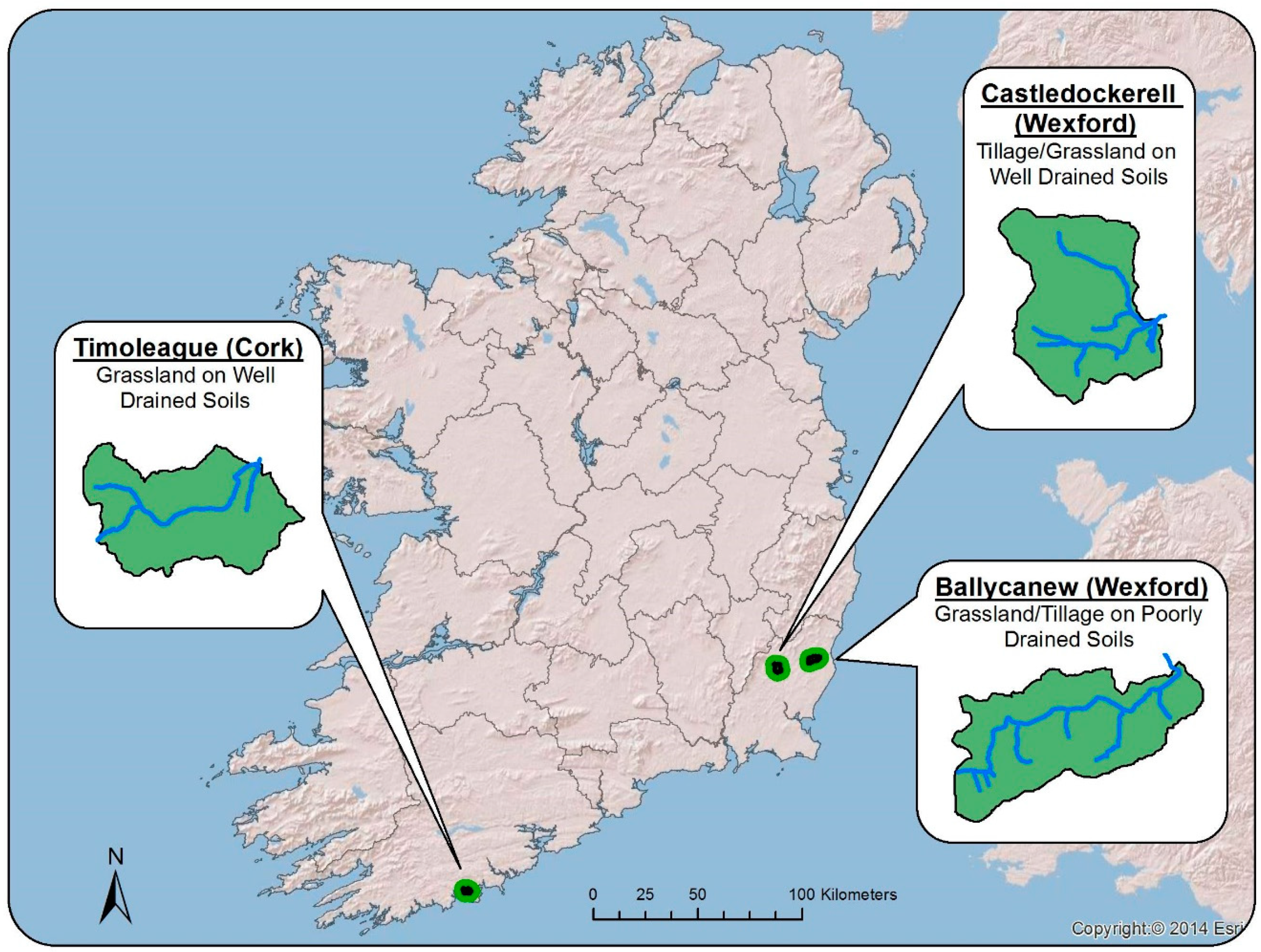
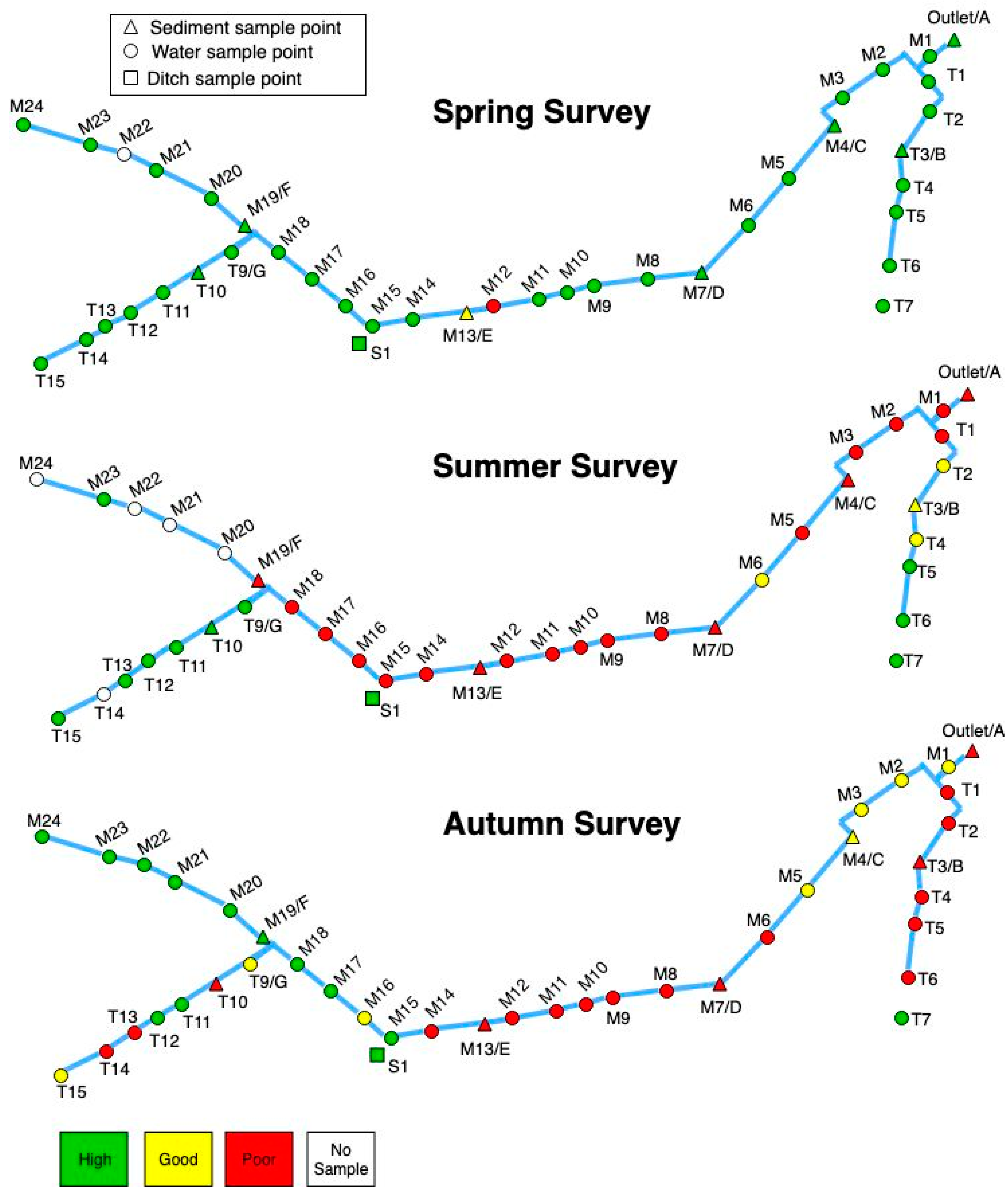
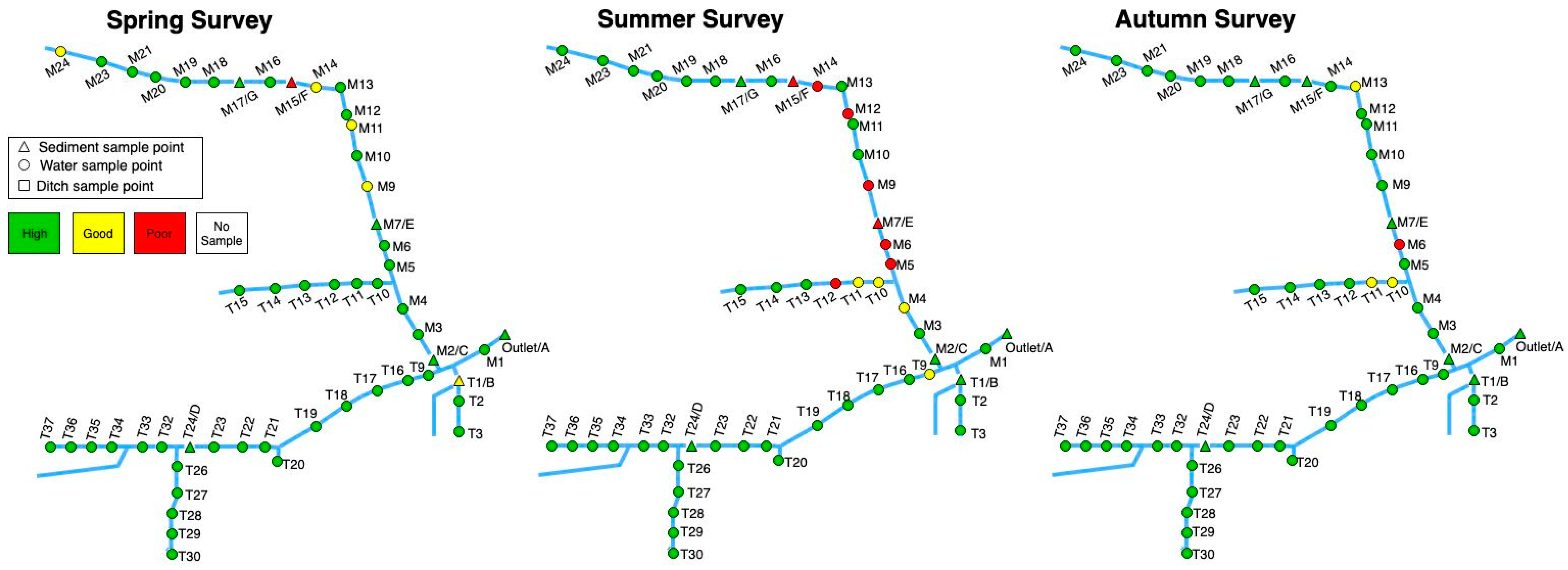
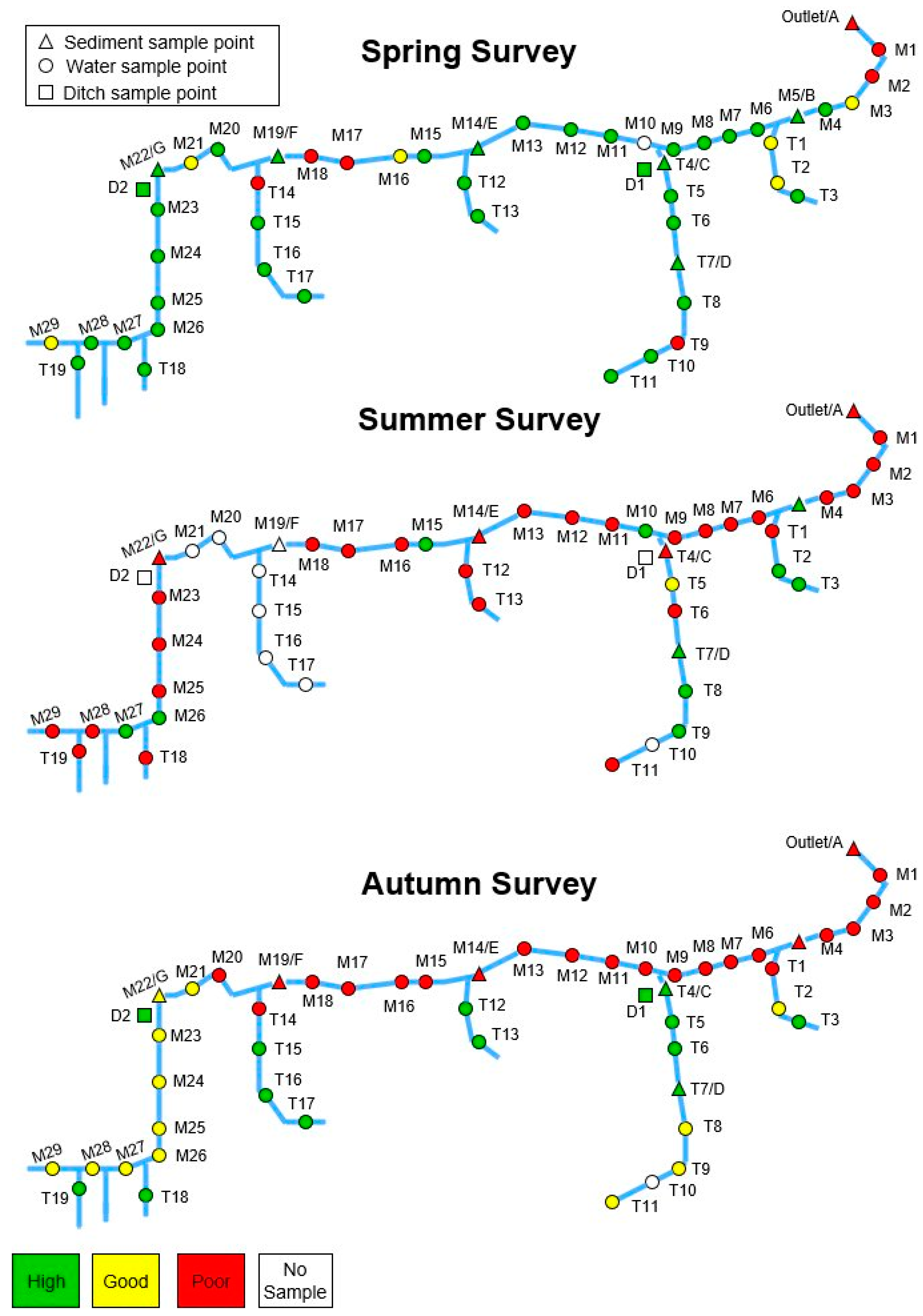
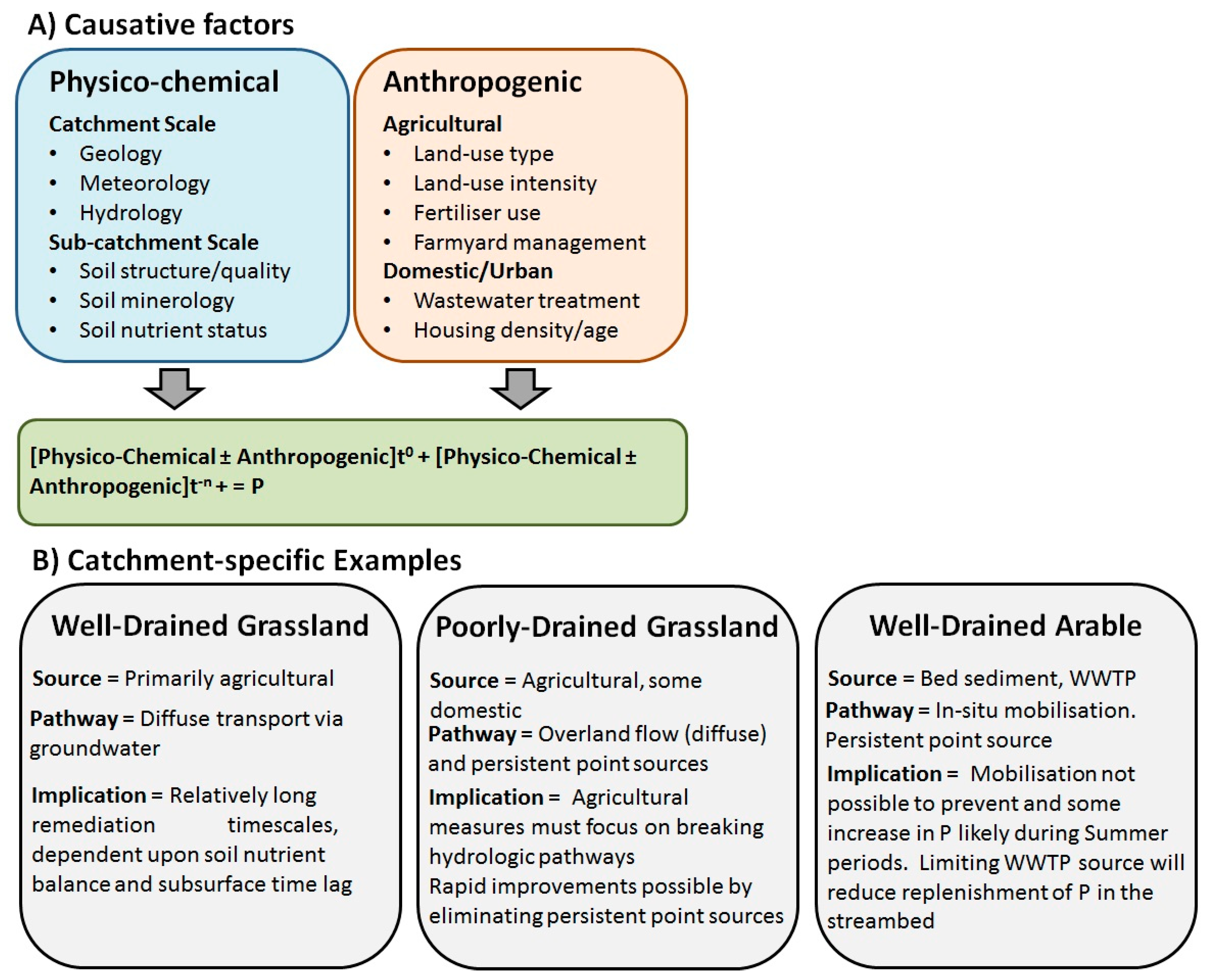
| Well-Drained Grassland | Well-Drained Arable | Poorly Drained Grassland | |
|---|---|---|---|
| Area | 7.6 km2 | 11.2 km2 | 11.9 km2 |
| Dominant Soil Drainage Class | Well-drained | Well-drained | Poorly drained |
| Average Annual Rainfall (mm) | 1121 | 1014 | 1043 |
| 70th Percentile Discharge | ≤ 4441 m3/s | ≤ 3871 m3/s | ≤ 1790 m3/s |
| Average Low-flow total reactive phosphorus (TRP) Conc. (mg L−1) | 0.063 | 0.045 | 0.084 |
| Average Annual TRP Conc. (mg L−1) | 0.063 | 0.029 | 0.076 |
| Average Annual total phosphorus (TP) Load (kg) | 1983 | 1172 | 3646 |
| Average Annual TP Load (kg/ha) | 261 | 105 | 306 |
| Well-Drained Grassland | Well-Drained Arable | Poorly Drained Grassland | |||||||||
|---|---|---|---|---|---|---|---|---|---|---|---|
| Season | Spring | Summer | Autumn | Spring | Summer | Autumn | Spring | Summer | Autumn | ||
| Sampling Date | 19 April 2017 | 5 July 2017 | 26 November 2017 | 3 May 2017 | 3 July 2017 | 11 November 2017 | 25 April 2017 | 11 July 2017 | 20 November 2017 | ||
| Daily Discharge (m3) | 9605 | 3100 | 7138 | 4290 | 4684 | 10508 | 3786 | 2068 | 3647 | ||
| Mean Outlet TRP (mg L−1) | 0.0346 | 0.0474 | 0.0497 | 0.0107 | 0.0245 | 0.0215 | 0.0566 | 0.0967 | 0.0787 | ||
| Full Watercourse | |||||||||||
| TRP (mg L−1) | Min. | 0.000 | 0.003 | 0.002 | 0.003 | 0.006 | 0.004 | 0.008 | 0.010 | 0.009 | |
| Mean | 0.010 | 0.040 | 0.032 | 0.011 | 0.019 | 0.015 | 0.024 | 0.046 | 0.037 | ||
| Max | 0.059 | 0.187 | 0.051 | 0.034 | 0.059 | 0.143 | 0.054 | 0.093 | 0.090 | ||
| Range | 0.059 | 0.184 | 0.049 | 0.031 | 0.053 | 0.139 | 0.046 | 0.083 | 0.081 | ||
| ≥ 0.035 | 3% | 57% | 50% | 0% | 11% | 2% | 14% | 71% | 53% | ||
| Main Stream | |||||||||||
| TRP (mg L−1) | Min. | 0.000 | 0.004 | 0.002 | 0.007 | 0.008 | 0.004 | 0.017 | 0.010 | 0.025 | |
| Mean | 0.012 | 0.054 | 0.030 | 0.015 | 0.021 | 0.020 | 0.026 | 0.052 | 0.044 | ||
| Max | 0.059 | 0.187 | 0.051 | 0.031 | 0.045 | 0.143 | 0.049 | 0.093 | 0.090 | ||
| Range | 0.059 | 0.183 | 0.049 | 0.024 | 0.037 | 0.139 | 0.032 | 0.083 | 0.065 | ||
| ≥ 0.035 | 4% | 90% | 43% | 0% | 24% | 5% | 17% | 85% | 76% | ||
| Tributaries | |||||||||||
| TRP (mg L−1) | Min. | 0.000 | 0.003 | 0.009 | 0.003 | 0.006 | 0.005 | 0.008 | 0.016 | 0.009 | |
| Mean | 0.007 | 0.020 | 0.034 | 0.009 | 0.013 | 0.009 | 0.020 | 0.034 | 0.026 | ||
| Max | 0.013 | 0.039 | 0.049 | 0.034 | 0.017 | 0.012 | 0.054 | 0.068 | 0.067 | ||
| Range | 0.013 | 0.036 | 0.040 | 0.031 | 0.011 | 0.007 | 0.046 | 0.052 | 0.058 | ||
| ≥ 0.035 | 0% | 7% | 60% | 0% | 3% | 0% | 10% | 43% | 20% | ||
| Al:P Ratio | ||||||||
|---|---|---|---|---|---|---|---|---|
| Sample Point | A | B | C | D | E | F | G | |
| Well-Drained Grassland | Summer | 4.09 | 4.56 | 4.13 | 4.84 | 6.27 | 9.75 | 5.36 |
| Autumn | 4.20 | 4.76 | 4.25 | 6.03 | 6.17 | 6.70 | 6.41 | |
| Well-Drained Arable | Summer | 11.16 | 3.78 | 10.66 | 16.34 | 10.90 | 3.77 | 12.60 |
| Autumn | 12.09 | 8.48 | 17.59 | 15.97 | 8.89 | 4.23 | 13.84 | |
| Poorly Drained Grassland | Summer | 6.87 | 6.07 | 14.48 | 8.31 | 8.67 | 5.48 | 5.40 |
| Autumn | 7.85 | 6.34 | 5.99 | 11.32 | 9.18 | 9.82 | 5.64 | |
© 2019 by the authors. Licensee MDPI, Basel, Switzerland. This article is an open access article distributed under the terms and conditions of the Creative Commons Attribution (CC BY) license (http://creativecommons.org/licenses/by/4.0/).
Share and Cite
Vero, S.E.; Daly, K.; McDonald, N.T.; Leach, S.; Sherriff, S.C.; Mellander, P.-E. Sources and Mechanisms of Low-Flow River Phosphorus Elevations: A Repeated Synoptic Survey Approach. Water 2019, 11, 1497. https://doi.org/10.3390/w11071497
Vero SE, Daly K, McDonald NT, Leach S, Sherriff SC, Mellander P-E. Sources and Mechanisms of Low-Flow River Phosphorus Elevations: A Repeated Synoptic Survey Approach. Water. 2019; 11(7):1497. https://doi.org/10.3390/w11071497
Chicago/Turabian StyleVero, Sara E., Karen Daly, Noeleen T. McDonald, Simon Leach, Sophie C. Sherriff, and Per-Erik Mellander. 2019. "Sources and Mechanisms of Low-Flow River Phosphorus Elevations: A Repeated Synoptic Survey Approach" Water 11, no. 7: 1497. https://doi.org/10.3390/w11071497
APA StyleVero, S. E., Daly, K., McDonald, N. T., Leach, S., Sherriff, S. C., & Mellander, P.-E. (2019). Sources and Mechanisms of Low-Flow River Phosphorus Elevations: A Repeated Synoptic Survey Approach. Water, 11(7), 1497. https://doi.org/10.3390/w11071497






